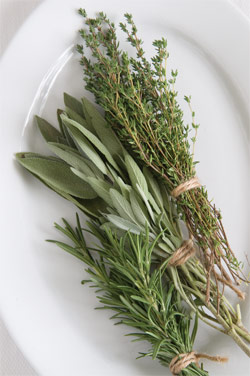- Succession-Planting Interval Chart for Herbs
- Growing Herbs in Containers | Tips for Production of Professional-Quality Container Herbs
- Herb Culture | Comparison Chart (PDF)
- Beyond Cilantro: Top 5 Culinary Herb Trends
- Mouthwatering Combinations: Culinary Herbs + Farm-Fresh Produce
- Destination Herb Farms: Hospitality Farming & Agritourism
- Growing Herb Plants for Direct-Market Sales
- Economic Outlook for Culinary Herbs
- Marketing Herb Plants | Building a Brand for Your Herb Business
- Overwintering Perennial Herbs
- Turning a Profit by Growing Herbs | The Useful Plants
Ideas for Generating Income from the Herbs You Grow
by Lynn Byczynski, Author & Founder of Growing for Market
Herbs are often called the useful plants, and with good reason. They are valuable for culinary, cosmetic, medicinal, and ornamental products, offering a world of mercantile possibilities. They can be sold as live plants all season long, sold freshly cut for culinary use, made into herbal bouquets, or dried and used in herbal crafts.
Take up the study of herbs yourself and become a local herb expert. As you help people see the many ways they can use herbs in their daily lives, your herb business will prosper. Here are a few ways to make herbs a profitable part of your market garden.
- Grow large plantings of the basic culinary herbs such as basil, dill, and parsley, because restaurant chefs usually purchase them by the pound. Succession-plant so you have a constant supply of fresh product. Pay particular attention to storage requirements of the culinary herbs because some are damaged by cold temperatures.
- Some chefs like to purchase the less common culinary herbs in pots that they can keep in the kitchen until they are needed in a recipe. If you're selling cut herbs to chefs, offer to grow herbs such as lemon basil and French tarragon in 4-inch pots. The chefs will get the freshest herbs possible and maybe even some regrowth if they can give the potted herbs sunshine and water between cuttings.
- For home cooks, pot up large patio containers of mixed herbs, with a few edible flowers such as viola and calendula for color. Think about the shape the planting will take once it has matured: place a tall, spiky plant in the center and surround it with mounding and cascading plants in different colors and textures. For best results, combine plants with similar water and sun requirements, such as rosemary, oregano, and thyme, which like it dry, or basils, parsley, and salad burnet, which like more water.
- In fall, sell potted herbs in attractive pots that can be brought inside when frost threatens. Focus on the herbs everyone will need for their upcoming holiday dinners: rosemary, sage, and thyme.
- At winter markets, sell a "Nature's Remedies" combination of potted or dried medicinal herbs known to help with cold, fever, and flu symptoms. For example, an infusion of savory can be gargled for sore throat, a steam bath with rosemary helps open nasal passages, and thyme tea helps soothe coughs.
- Cater to the cat fanciers in your market. Catnip and catmint are both easy to grow and can be sold in containers, or dried, or crafted into cat toys. Offer pots of cat-grass: wheat, rye, or barley seeds planted bumper-to-bumper and grown to about 4" tall.
- Create your own line of gift items to sell or give. Dried lavender sachets, herb vinegars, herbal teas, lemon verbena soap, candles, and similar nonperishable items can bring in a significant amount of late-season revenue, if you plan ahead and grow enough for fall and winter events.
About the Author
Lynn Byczynski was growing organic vegetables and cut flowers for market when she decided to create a magazine that would help market gardeners nationwide share experiences and information. Her first issue of Growing for Market appeared in January 1992, and GFM has been published continuously ever since, becoming renowned in the market-gardening world for realistic articles that provide practical, how-to information about growing and selling produce and flowers.
Byczynski and her family have been growing vegetables and cut flowers since 1988, selling through CSAs, at farmers' markets, to chefs, grocery stores, and florists. They currently grow cut flowers and hoophouse tomatoes on about 2 acres of their 20-acre farm near Lawrence, Kansas.
She is also the author/editor of two of our favorite books about market farming, The Flower Farmer and The Hoophouse Handbook.
Byczynski and her family have been growing vegetables and cut flowers since 1988, selling through CSAs, at farmers' markets, to chefs, grocery stores, and florists. They currently grow cut flowers and hoophouse tomatoes on about 2 acres of their 20-acre farm near Lawrence, Kansas.
She is also the author/editor of two of our favorite books about market farming, The Flower Farmer and The Hoophouse Handbook.




